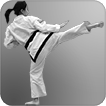





"There are three steps to learning a hyung. First, you learn which way to turn and which techniques to do. Second, you perfect the stances and techniques. Third, you apply the techniques. The third step is also referred to as the fire; performing each technique with maximum power and intensity as though you were truly fighting for your life with each move."
- Ed Bailey
Primary considerations:
Stances, Chambers (hand and foot), Power, Techniques, and Concentration.
Additional considerations:
Congruity, Breath Control, Timing, and Beginning and ending at the same point.
"Execute each technique as if your life depends on it. Walking thru your pattern without applying power, focus and the necessary attention to detail will not enhance your ability to effectively defend yourself should the need ever arise."
- General Choi Hong Hi
Interpretation
The name of the pattern, the number of movements, and the diagrammatic symbol of each pattern symbolizes either heroic figures in Korean history or instances relating to historical events.
CHON-JI means literally The Heaven the Earth. It is, in the Orient, interpreted as the creation of the world or the beginning of human history, therefore, it is the initial pattern played by the beginner. This pattern consists of two similar parts; one to represent the Heaven and the other the Earth. (see video)
Chon-Ji advice: Don't let your low block rise when you step forward to punch. Imagine that you are still pressing your block against your attacker's kick as you step forward to punch.
DAN-GUN is named after the holy Dan-Gun, the legendary founder of Korea in the year of 2333 B.C. (see video)
DO-SAN is the pseudonym of the patriot Ahn Chang-Ho (1876-1938). The 24 movements represent his entire life which he devoted to furthering the education of Korea and its independence movement. (see video)
WON-HYO was the noted monk who introduced Buddhism to the Silla Dynasty in the year of 686 A.D. (see video)
YUL-GOK is the pseudonym of a great philosopher and scholar Yi I (1536-1584) nicknamed "the Confucius of Korea." The 38 movements of this pattern refer to his birthplace on 38° latitude and the diagram ( 士 ) represents "scholar." (see video)
JOONG-GUN is named after the patriot Ahn Joong-Gun who assassinated Hiro-Bumi Ito, the first Japanese governor-general of Korea, known as the man who played the leading part in the Korea-Japan merger. There are 32 movements in this pattern to represent Mr. Ahn's age when he was executed at Lui-Shung prison (1910). (see video)
TOI-GYE is the pen name of the noted scholar Yi Hwang (16th century), an authority on neo-Confucianism. The 37 movements of the pattern refer to his birthplace on 37° latitude, the diagram ( 士 ) represents "scholar." (see video)
HWA-RANG is named after the Hwang youth group which originated in the Silla Dynasty in the early 7th century. The 29 movements refer to the 29th Infantry Division, where Taekwon-Do developed into maturity. (see video)
CHOONG-MOO was the name given to the great Admiral Yi Soon-Sin of the Lee Dynasty. He was reputed to have invented the first armoured battleship (Kobukson) in 1592, which is said to be the precursor of the present day submarine. The reason why this pattern ends with a left hand attack is to symbolize his regrettable death, having no chance to show his unrestrained potentiality checked by the forced reservation of his loyalty to the king. (see video)
Reference: General Choi Hong Hi 1988, Taekwon-Do, International Taekwon-Do Federation, Hong Kong